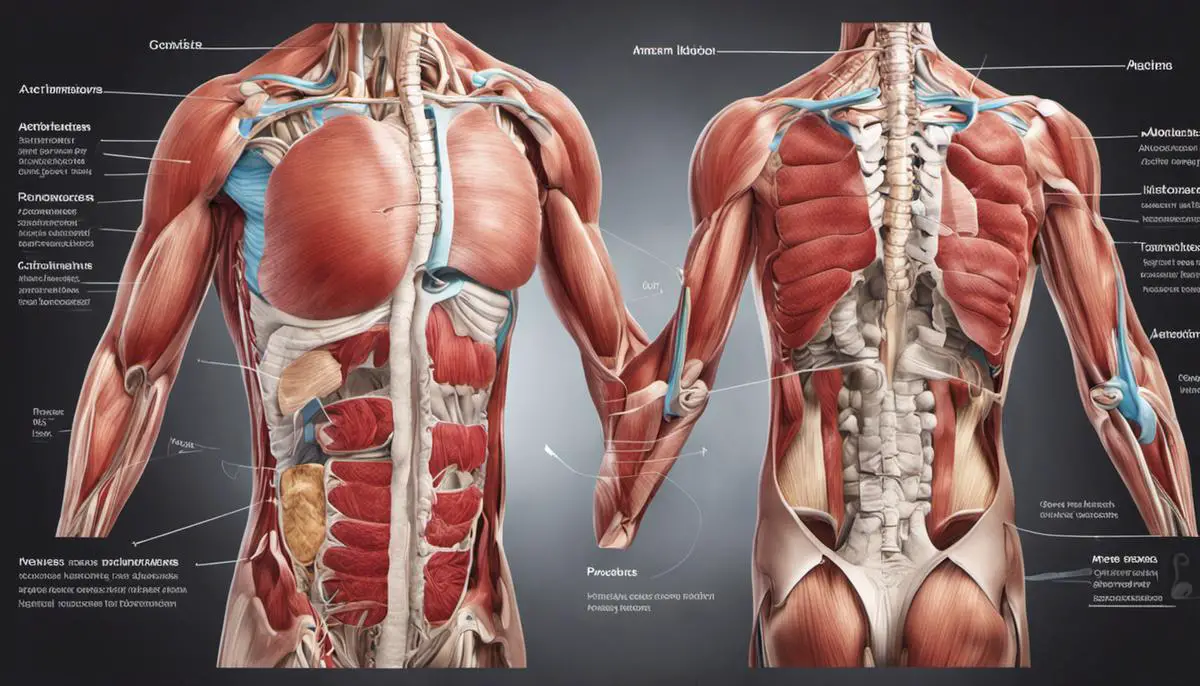In the broad world of fitness and weight loss, numerous methods promise desirable results, among which is the intriguing belly massage technique. This procedure explores the connection between physically stimulating the abdominal area and promoting weight loss, a concept that merits comprehensive understanding. The process, along with its associated risks, benefits, and supportive testimonies, unfolds through robust scientific studies. With its roots deeply embedded in human anatomy, especially the abdomen, the belly massage technique interacts with our muscles, fat tissues, and digestive system. This interaction facilitates the understanding of diverse abdominal massage techniques designed for weight loss, and guides towards a path of encompassing knowledge about a balanced lifestyle and diet.
Understanding Belly Massage
Understanding Belly Massage
Belly massage for weight loss is based on the principle of stimulating the digestive and circulatory systems within the body. The massage focuses on specific pressure points in the abdomen which are thought to correspond to different organs involved in digestion. Application of pressure on these points may ostensibly help stimulate metabolism, detoxify the body, and break down fat tissues resulting in weight loss.
How Belly Massage Promotes Weight Loss
The crux of belly massage for weight loss lies in the hypothesis that it can affect the body’s adipose tissue- fat cells located under the skin. Massaging the abdomen may help break down these fat cells and increase blood flow, which could potentially result in weight loss.
Furthermore, massaging encourages the contraction of muscles which can stimulate the lymphatic system, responsible for removing waste and toxins from bodily tissues. This enhancement of the detoxification process may contribute to weight loss by eliminating waste products that could be contributing to weight gain.
Risks and Benefits of Belly Massage
While the benefits of belly massage for weight loss may seem encouraging, it’s vital to approach such a procedure with pragmatism. Belly massages are generally safe when done correctly, but can cause discomfort or injury if not performed properly or if excessive pressure is applied.
The primary benefits of belly massage focus on digestion and circulation. An effective stomach massage can help stimulate the digestive system, tackling issues such as constipation and bloating. Improved digestion could indirectly help in the process of weight loss.
However, as indicated earlier, improper technique could cause injury, and it may not be suitable for everyone. For instance, individuals with conditions like hernias, pregnancy, or digestive diseases should consult their doctors before initiating belly massage.
Review of Relevant Scientific Studies and Testimonials
A review of scientific literature reveals that there’s limited rigorous scientific research validating the efficacy of belly massages specifically in achieving weight loss. Most of the studies conducted in this area have been inconclusive or contradictory, falling short of providing robust evidence for any significant weight loss merit.
Testimonials, however, often tell a different story. Many people who routinely incorporate belly massages into their overall health and wellness regimen report feeling healthier, less bloated, and some even claim noticeable weight loss over time.
Familiarizing Yourself with Different Techniques
Multiple techniques can be used for belly massage, and these usually depend on the specific needs and comfort levels of the individual. Commonly used methods include circular motions, “I Love U” techniques, and shiatsu or pressing specific points on the abdomen.
Circular motions involve applying light pressure and tracing circles around the navel, both clockwise and counter-clockwise. The “I Love U” technique involves three separate strokes that form these respective letters on the abdomen and it aims to mimic the pathway of the colon to stimulate bowel movement. Shiatsu, a traditional Japanese method of massage, involves applying pressure using the fingers, thumbs, and palms at specific points on the abdomen.
Remember to start gradually with light pressure and short durations, especially if you are new to the practice. It might also be helpful to learn from a certified therapist or take a professional course to ensure correct technique and avoid potential risks.
In conclusion
while belly massage can provide a number of digestive and circulatory benefits, its efficacy as a solitary weight loss strategy remains inconclusive. As with any health regimen, it’s highly recommended to incorporate other factors such as a balanced diet, regular exercise, and appropriate rest for a more holistic approach to weight loss. Always consult a healthcare professional before beginning any new health or weight loss program.

Anatomy and Physiology
Understanding Human Anatomy: The Abdominal Area
The human abdomen, often referred to as the belly, is a complex structure comprising various muscles, organs, and fat tissue layers. Primarily, the stomach, liver, pancreas, and intestines are key organs involved in the digestion process. Additionally, the abdomen contains several important muscles such as the rectus abdominis (six-pack muscles), transverse abdominis (deep core muscle), and oblique muscles (side abs). Fat tissues accumulate mainly in the subcutaneous and visceral regions, both of which are areas of focus in weight loss.
Importance of Abdominal Muscles
Abdominal muscles play a critical role in stabilizing the torso and maintaining posture. They consist of four main groups: the rectus abdominis, transversus abdominis, internal obliques, and external obliques. The rectus abdominis runs vertically down the front of the abdomen, assisting with flexion and rotation of the torso. The transverse muscles hold a deeper position, providing structural support by pulling the abdominal wall inward. The internal and external oblique muscles help with rotation and lateral flexion of the body.
Fat Tissues in the Abdominal Area
Abdominal fat refers to the adipose tissue that accumulates around the stomach and abdomen. There are two types: subcutaneous fat and visceral fat. Subcutaneous fat lies beneath the skin and on top of the abdominal muscles. Visceral fat, however, is stored within the abdominal cavity, surrounding the internal organs. From a health perspective, visceral fat is particularly concerning as it is associated with a range of health issues, including type 2 diabetes and heart disease.
Digestive System and Weight Loss
The digestive process begins the moment that food is ingested. The stomach, intestines, liver, and pancreas all work together to break food down into nutrients to be extracted and used by the body. Understanding how this system works can provide insights into weight loss mechanisms. For instance, slow and inefficient digestion can lead to weight gain, while a healthy, functioning digestive system enables better nutrient absorption and helps maintain a balanced body mass.
Abdominal Massage for Weight Loss
Giving the belly area a massage can stimulate the digestive system, relieving constipation, bloating, and other digestive distress. As you massage your abdominal area, you manually stimulate the layers of your digestive tract, encouraging movement and promoting more effective food processing. Massage also creates heat and friction, which can help melt away visceral fat.
There have been studies showing that abdominal massage can improve gastric motility and the tone of the abdominal wall muscles which could indirectly lead to weight loss. However, while belly massage is beneficial in many ways, it should not be seen as an alternative to regular exercise and a balanced diet. It is one of the many tools that together can support weight loss and a healthier lifestyle.

Abdominal Massage Techniques
Understanding Abdominal Massage for Weight Loss
Abdominal massage, which may also be referred to as stomach or belly massage, is a non-invasive approach to potentially aid in weight loss. It is usually complemented with a healthy diet and regular exercise for best results, as no single technique can solely carry weight loss success. Belly massage techniques are rooted in improving digestion and reducing bloating, both which can contribute to a leaner waistline. They also stimulate your internal organs, can aid in detoxification, and improve metabolism, all beneficial for weight loss.
Specific Belly Massage Techniques for Weight Loss
Deep Kneading Technique
The deep kneading technique primarily aims to break up adipose tissue – the body’s normal fat – and releasing it into your system to use as energy, therefore helping with weight loss:
- Start by lying down comfortably on your back on a flat surface.
- Warm your hands by rubbing them together to generate heat.
- Place your right hand flat on your belly button.
- Begin to massage in small circles around your navel, gradually widening those circles using a firm and even pressure.
- Spend about a minute massaging the entire stomach area in this manner.
Compression Technique
The compression technique helps increase the circulation in your abdominal region:
- Lie down comfortably on your back on a flat surface.
- Warm your hands and place one of them flat on your belly.
- Use the other hand to press down directly on top of the first hand.
- Apply gentle pressure and slowly move your hands around your entire stomach area.
- Continue this for about a minute.
Shaking or Vibration Technique
The shaking or vibration belly massage technique helps to ignite your digestive fire and stimulate the stomach muscles:
- Lie comfortably on your back on a flat surface.
- Warm your hands and place one hand flat on your belly.
- Keep your fingers together and do a back-and-forth shaking or vibration motion.
- Cover the entire abdominal area while maintaining this shaking motion.
- Continue this action for about a minute.
Investing Time to Master the Techniques
Practicing these techniques regularly can help you achieve improved comfort and efficiency in the execution. Over time, persistence can lead to more effective results and perhaps a leaner, healthier you. Understanding the process behind weight loss and health, beyond the mechanics of belly massage, is essential to foster a holistic approach in achieving your health goals.

Lifestyle and Diet
Understanding the Basics
For successful weight loss, understanding the basics of a healthy lifestyle and proper diet is the stepping-stone. It’s crucial to eat a balanced diet consisting of fruits, vegetables, lean proteins, and whole grains in proportion. Drinking ample water, getting good sleep, and regular exercise not only helps in weight loss but also improves overall health. Including belly massage as part of your weight loss regimen can supplement these efforts.
The Role of Belly Massage in Weight Loss
Belly massage isn’t a direct way to lose weight but can aid weight loss by improving digestion, eliminating toxins, and reducing stress levels, which further influences eating patterns. Massage has been shown to increase serotonin, a hormone that induces feelings of happiness, and decrease cortisol levels, a stress hormone which can often lead to overeating.
Types of Belly Massage
There are multiple types of belly massages you can choose from, like Chi Nei Tsang, which focuses on abdominal organs, and Ayurvedic Abhyanga massage, which uses oil and movement patterns to help remove toxins. We recommend you to undergo these massages under a certified professional for effective results.
Diet Plans that Complement
Diet plans that complement belly massage involve consuming food which supports digestion and detoxification. Increase your intake of fiber-rich foods such as fruits, vegetables, and whole grains to improve digestion. Consume lean proteins such as chicken, fish, and legumes to keep you satiated. To help the body in detoxification, drink ample water and eat antioxidant-rich foods like berries and nuts.
Exercise and Belly Massage: A Cohesion
Exercise is an inevitable part of weight loss. Along with belly massage, incorporating aerobic exercises like walking, jogging and cycling can help burn calories and belly fat. Strength training exercises like squats and lunges can help tone muscles and increase metabolism. As for cohesion, practicing yoga along with belly massage could be beneficial as it includes several poses directly targeted towards the belly and aids digestion.
Timing your Massages and Diet
Try to schedule your belly massage when the stomach is relatively empty to avoid discomfort. This includes before a meal or several hours after a meal. Hydrating with warm water or green tea after the massage can help to flush out the toxins from the body.
Following a healthy lifestyle, a balanced diet plan combined with belly massages and a regular workout routine might not lead to drastic weight loss instantly. However, it will improve your metabolism, digestion, help manage stress levels better and aid in gradual, healthy weight loss. Personalize your diet plan and exercise routine according to your body type and comfort for a sustainable weight loss journey.

Embarking upon the journey of weight loss with the aid of belly massage opens a gateway to a comprehensive lifestyle change. It establishes a strong correlation between manual abdominal stimulation and shedding extra pounds. Digging deeper into this methodology amplifies knowledge about the human body, particularly the abdominal arena, which interacts symbiotically with beneficial massage techniques. While understanding the relevance of a wholesome diet and lifestyle to support this weight loss method, it is crucial to decipher the science, embrace the practice, and take well-informed steps towards a healthier future.
